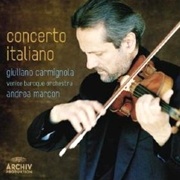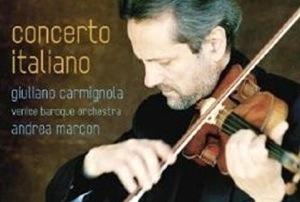Musicians who come from recording on “modern” violin (cello, piano, whatever) to recording on “period” (ditto) generally sort themselves into two heaps. Some check out “period” playing because they have noticed that some of their colleagues and of their listeners are interested; they try it, mess around with it (as we might say), and then go back to what they were doing before. They don’t scorn the “period” shtick, but they aren’t interested in living in that world full-time.
Others seem, having once put a toe into those waters, to find it very difficult ever again to towel themselves dry.

I think that the first time I saw the name of Giuliano Carmignola, it was on a disc on a small independent label, as first violinist in a (modern-instrument, of course) performance of the Brahms string sextets. The next time, he was a soloist on a period-instrument Vivaldi recording that got, as it happened, a certain amount of positive attention.
For those who don’t know, Carmignola went from three Vivaldi discs on the independent Swiss label Divox (recordings recently rereleased as a package by Brilliant Classics, and seriously about the best classical-music bargain I know of) to a Sony contract under which he recorded mostly unrecorded Vivaldi, to a DG contract under which he has recorded stuff even less familiar (if that be possible) than unrecorded Vivaldi.
His most recent disc is called Concerto Italiano, a bland title that does credit to DG/Universal. (Sony, given the same material, would most likely have called it Violino Pazzo or some such.) There are four pieces here, three by composers that all but the most earnest students of 18th-century violin music will never even have heard of.
The possibly familiar name is that of Pietro Nardini, which violinists might remember from one or two pieces in anthologies. Yet a G-major concerto by Nardini gets its first recording here, as do concertos by Domenico dall’Oglio and Michele Stratico. Only a C-major concerto by Antonio Lolli seems to have been recorded before.
Listen to the Music
Concerto for Violin in C major, III - Allegro
Pietro Nardini
Concerto for Violin in G major, I - Allegro
And the dall’Oglio, Stratico, and Nardini have a second distinction in common: The performing materials come from a collection of Italian manuscript music at UC Berkeley.
“Archaeological operations don’t interest me,” says Carmignola in the program note, referring to the archival work that went into this recording. But, seriously, if the rest of the material in Cal’s Italian instrumental music archive is anything like this, someone should organize a dig. We’re talking about a collection that has a book-length catalog. (Stratico alone occupies nearly a hundred pages of it.)
It’s not difficult to hear why the Lolli has attracted other violinists; there can’t be many other 18th-century works so crammed full of violin pyrotechnics. Yet I confess I prefer some of the less-flashy music here — the serene slow movement of the Stratico, the rambunctious finale of the dall’Oglio. Or the finale of the Nardini, which begins with deceptive easygoingness and turns out to be nearly as nasty technically as anything else on the disc.
Throughout, Carmignola plays as we’ve come to expect. He’s elegant, but in a swashbuckling, James Bondish sort of way; when he comes through a notably nasty passage, you can almost see him casually brush the excess rosin dust off his tux and resume the conversation he was having when the bomb exploded.

